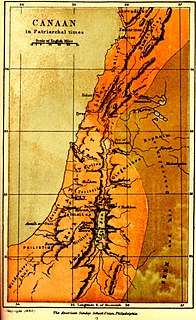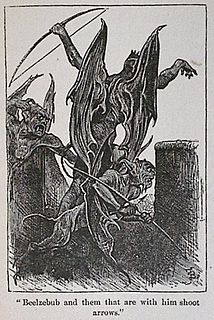Related Research Articles
Rabbinic Judaism considers some names of God so holy that, once written, they should not be erased: YHWH, Adonai, El ("God"), Elohim ("God"), Shaddai ("Almighty"), and Tzevaot ; some also include Ehyeh. Early authorities considered other Hebrew names mere epithets or descriptions of God and wrote that they and names in other languages may be written and erased freely. However, some moderns advise special care even in these cases, and many Orthodox Jews have adopted the Chumras of the writing "G-d" instead of "God" in English or saying Ṭēt-Vav instead of Yōd-Hē for the number fifteen or Ṭēt-Zayin instead of Yōd-Vav for the number sixteen in Hebrew.

Yahweh was the national god of ancient Israel and Judah. The origins of his worship reach at least to the early Iron Age, and likely to the Late Bronze Age. In the oldest biblical literature, he is a storm-and-warrior deity who leads the heavenly army against Israel's enemies; at that time the Israelites worshipped him alongside a variety of Canaanite gods and goddesses, including El, Asherah and Baal; in later centuries, El and Yahweh became conflated and El-linked epithets such as El Shaddai came to be applied to Yahweh alone, and other gods and goddesses such as Baal and Asherah were absorbed into the Yahwist religion.

Baal, or Baʽal, was a title and honorific meaning "owner", "lord" in the Northwest Semitic languages spoken in the Levant during antiquity. From its use among people, it came to be applied to gods. Scholars previously associated the theonym with solar cults and with a variety of unrelated patron deities but inscriptions have shown that the name Ba'al was particularly associated with the storm and fertility god Hadad and his local manifestations.

ʼĒl is a Northwest Semitic word meaning "god" or "deity", or referring to any one of multiple major ancient Near Eastern deities. A rarer form, ʼila, represents the predicate form in Old Akkadian and in Amorite. The word is derived from the Proto-Semitic *ʔil-, meaning "god".

Atum, sometimes rendered as Atem or Tem, is an important deity in Egyptian mythology.
Sheol in the Hebrew Bible is a place of darkness to which all the dead go, both the righteous and the unrighteous, regardless of the moral choices made in life, a place of stillness and darkness cut off from life and from God. The inhabitants of Sheol are the "shades" (rephaim), entities without personality or strength. Under some circumstances they are thought to be able to be contacted by the living, as the Witch of Endor contacts the shade of Samuel for Saul, but such practices are forbidden. The word Sheol is translated as "netherworld", "grave", and "Hades" in some translations of the Hebrew Bible, but left untranslated in others.

Raphael is an archangel first mentioned in the Book of Tobit and in 1 Enoch, both dating from the last few centuries before Christ. In later Jewish tradition, he became identified as one of the three heavenly visitors entertained by Abraham at the Oak of Mamre. He is not named in either the New Testament or the Quran, but later Christian tradition identified him with healing and as the angel who stirred waters in the Pool of Bethesda in John 5:2-4,. and in Islam, where his name is Israfil, he is understood to be the unnamed angel of Quran 6:73, standing eternally with a trumpet to his lips, ready to announce the Day of Resurrection. In Gnostic tradition, Raphael is represented on the Ophite Diagram.
Nisroch was, according to the Hebrew Bible, an Assyrian god in whose temple King Sennacherib was worshiping when he was assassinated by his sons Adrammelech and Sharezer. The name is unknown in Mesopotamian sources, but it has been tentatively identified as the god of agriculture.
Zondervan is an international Christian media and publishing company located in Grand Rapids, Michigan. Zondervan is a founding member of the Evangelical Christian Publishers Association (ECPA). They are a part of HarperCollins Christian Publishing, Inc. and has multiple imprints including Zondervan Academic, Zonderkidz, Blink, and Editorial Vida. Zondervan is the commercial rights holder for the New International Version (NIV) Bible in North America.
Yam is the god of the sea in the Canaanite pantheon. He takes the role of the adversary of Baal in the Ugaritic Baal Cycle.

The Canaanite religion was the group of ancient Semitic religions practiced by the Canaanites living in the ancient Levant from at least the early Bronze Age through the first centuries AD. Canaanite religion was polytheistic and, in some cases, monolatristic.
Shalim is a god in Canaanite religion, mentioned in inscriptions found in Ugarit in Syria. William F. Albright identified Shalim as the god of dusk and Shahar as god of the dawn. In the Dictionary of Deities and Demons in the Bible, Shalim is also identified as the deity representing Venus or the "Evening Star" and Shahar the "Morning Star". His name derives from the triconsonantal Semitic root Š-L-M. The city of Jerusalem was named after him.

Baalshamin, also called Baal Shamem and Baal Shamaim, was a Northwest Semitic god and a title applied to different gods at different places or times in ancient Middle Eastern inscriptions, especially in Canaan/Phoenicia and Syria. The title was most often applied to Hadad, who is also often titled just Ba‘al. Baalshamin was one of the two supreme gods and the sky god of pre-Islamic Palmyra in ancient Syria. There his attributes were the eagle and the lightning bolt, and he perhaps formed a triad with the lunar god Aglibol and the sun god Malakbel. The title was also applied to Zeus.

Gad was the name of the pan-Semitic god of fortune, usually depicted as a male but sometimes as a female. and is attested in ancient records of Aram and Arabia. Gad is also mentioned in the bible as a deity in the Book of Isaiah, as having been worshipped by a number of Hebrews during the Babylonian captivity. Gad apparently differed from the god of destiny, who was known as Meni. The root verb in Gad means cut or divide, and from this comes the idea of fate being meted out.

Table I gives an overview of the periods and dates ascribed to the various books of the Bible. Tables II, III and IV outline the conclusions of the majority of contemporary scholars on the composition of the Hebrew Bible and the Protestant Old Testament, the deuterocanonical works, and the New Testament. Some books are considered pseudepigrapha - the person traditionally cited as the author is not the person who actually wrote the text; for some books there appear to have been multiple authors.

Beelzebub or Beelzebul is a name derived from a Philistine god, formerly worshipped in Ekron, and later adopted by some Abrahamic religions as a major demon. The name Beelzebub is associated with the Canaanite god Baal.
The origins of Judaism according to the traditions of the Jews and the teachings of Judaism are described and explained in the Torah that regards Abraham the Hebrew as the first "Jew", and hence of Judaism as a monotheistic religion, and then through his descendants, namely Jacob and the Children of Israel, as the originators of the Jewish people following the Exodus and of their religion as given in the Torah, traditionally based on the 613 commandments, that the Hebrews/Israelites/Jews were commanded by God to believe in, observe and practice as instructed in the Torah. See the main article about Judaism for the origins of the term and meaning.
The Dictionary of Deities and Demons in the Bible (DDD) is an academic reference work edited by Karel van der Toorn, Bob Becking and Pieter W. van der Horst which contains academic articles on the named gods, angels, and demons in the books of the Hebrew Bible, Septuagint and Apocrypha, as well as the New Testament and patristic literature. Its first edition (Brill) appeared in 1995 and was chosen by Choice magazine of the American Library Association as Best Reference Work of 1996. The second extensively revised edition appeared in 1999, under the auspices of the Faculty of Theology of Utrecht University. An electronic edition appeared in 2001. Advisors included Hans Dieter Betz, André Caquot (1923–2004), Jonas C. Greenfield (1926–1995), Erik Hornung Professor of Egyptology at Basel University, Michael E. Stone of the Hebrew University of Jerusalem, and Manfred Weipert of the University of Heidelberg.
References
- ↑ Orr, James (1915). The International Standard Bible Encyclopaedia - Volume 1. Howard-Severance Company. p. 347. Retrieved August 24, 2015.
- ↑ Karel van der Toorn; Bob Becking; Pieter Willem van der Horst (1999). Dictionary of Deities and Demons in the Bible. William B. Eerdmans Publishing Company. p. 145. ISBN 0802824919 . Retrieved August 24, 2015.
- ↑ Fleming, William (1838). gazetteer of the Old and New Testaments: to which is added the natural history of the Bible. Edinburgh Printing and Publishing Company. p. 251 . Retrieved August 25, 2015.
Ba'al Hermon.
- ↑ James Dixon Douglas; Merrill Chapin Tenney (2011). Zondervan Illustrated Bible Dictionary. Zondervan. p. 151. ISBN 978-0310229834 . Retrieved August 24, 2015.